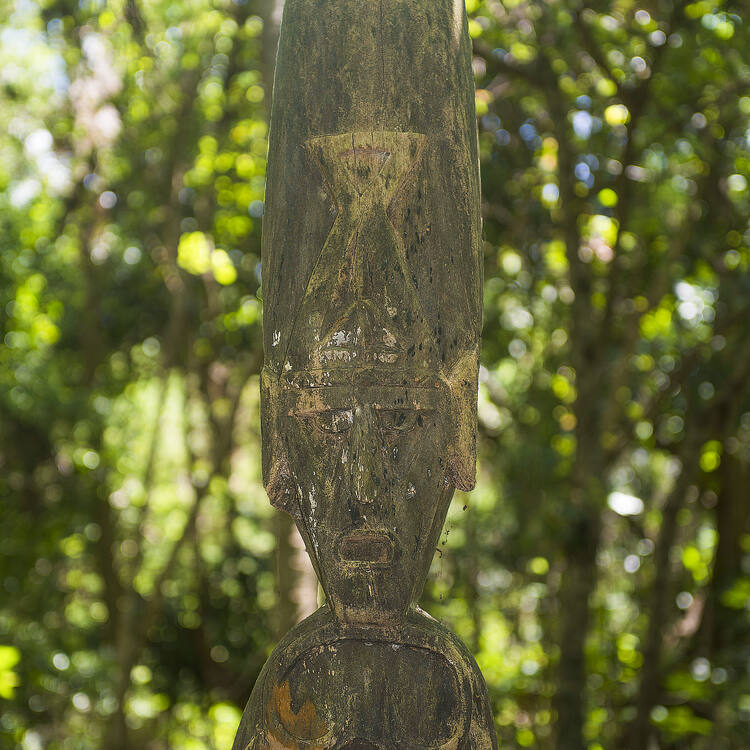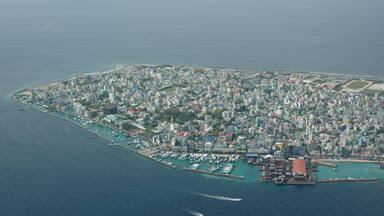Chief Roi Mata’s Domain
Chief Roi Mata’s Domain
Chief Roi Mata’s Domain is the first site to be inscribed in Vanuatu. It consists of three early 17th century AD sites on the islands of Efate, Lelepa and Artok associated with the life and death of the last paramount chief, or Roi Mata, of what is now Central Vanuatu. The property includes Roi Mata’s residence, the site of his death and Roi Mata’s mass burial site. It is closely associated with the oral traditions surrounding the chief and the moral values he espoused. The site reflects the convergence between oral tradition and archaeology and bears witness to the persistence of Roi Mata’s social reforms and conflict resolution, still relevant to the people of the region.
Description is available under license CC-BY-SA IGO 3.0
Domaine du chef Roi Mata
Le domaine du chef Roi Mata est le premier bien du Vanuatu à être inscrit sur la Liste. Ce domaine consiste en trois sites des îles d'Efate, de Lelepa et d'Artok qui sont associés avec la vie et la mort, aux alentours de 1600 après JC, du dernier détenteur du titre de chef ou Roi Mata dans ce qui est aujourd'hui le centre du Vanuatu. Le bien comprend la demeure du Roi Mata, le site de sa mort et un site funéraire collectif. Il est étroitement associé aux traditions orales entourant le chef et aux valeurs morales qu'il défendait. Le site reflète la convergence entre la tradition orale et l'archéologie; il témoigne de la persistence des réformes sociales du Roi Mata qui ont mis fin à des conflits qui restent encore d'actualité pour les habitants de la région.
Description is available under license CC-BY-SA IGO 3.0
ملكية الرئيس روا ماتا
تتكون ملكية الرئيس روا ماتا (فانواتو) من ثلاثة مواقع في جزر إيفات وليليبا وأرتوك، وترتبط بحياة وموت آخر رئيس للقبيلة، أو "روا ماتا"، في مطلع القرن السابع عشر الميلادي في ما يُعرف اليوم بفانواتو الوسطى. تشمل الملكية مقر إقامة روا ماتا، والموقع الذي شهد موته، وموقع المقبرة الجماعية التي دُفن فيها. كما يرتبط الموقع ارتباطاً وثيقاً بالتقاليد الشفهية التي كانت سائدة في محيط الرئيس، والقيم الأخلاقية التي تبناها. يعكس الموقع أيضاً التقارب بين التقليد الشفهي وعلم الآثار القديمة، ويشهد على ديمومة الإصلاحات الاجتماعية وسبل حل النزاعات التي اعتمدها روا ماتا والتي ما زالت تلائم سكان المنطقة.
source: UNESCO/CPE
Description is available under license CC-BY-SA IGO 3.0
Владения вождя Роя Маты
В состав объекта входят три острова - Эфейт, Лелепа и Арток. Он получил свое название в память о жизни и смерти Роя Маты, последнего вождя (примерно 1600 г.) земель, образующих центральную часть современного Вануату. В объект включены резиденция вождя, место его смерти и место его захоронения в общей могиле. Объект интересен своей связью с передаваемыми из поколения в поколение традициями, которыми был окружен вождь, и теми моральными ценностями, которых он придерживался. Он также интересен тесной связью между этими традициями и археологией. Объект является свидетельством проведения Роем Матой решительных социальных реформ и политики разрешения конфликтов, сохраняющих свою актуальность и поныне.
source: UNESCO/CPE
Description is available under license CC-BY-SA IGO 3.0
Dominios del jefe Roi Mata
Es el primer sitio inscrito en este país. Consiste en tres sitios del siglo XVII situados en las islas de Efaté, Lelepa y Artok (actualmente en el centro de Vanuatu) asociados con la vida y la muerte del último detentor del título de jefe o Roi Mata. El bien inscrito comprende la morada del Roi Mata, el lugar en el que murió y un sitio funerario colectivo. Está estrechamente asociado con las tradiciones orales de ese jefe y con los valores morales que defendía. El sitio refleja la convergencia entre la tradición oral y la arqueología. Atestigua también la persistencia de las reformas sociales emprendidas por el Roi Mata, que pusieron fin a conflictos que todavía son actuales para los habitantes de la región.
source: UNESCO/CPE
Description is available under license CC-BY-SA IGO 3.0
首長ロイ・マタの地
source: NFUAJ
Domein van Chief Roi Mata
Source: unesco.nl
Outstanding Universal Value
The continuing cultural landscape of Chief Roi Mata’s domain, Vanuatu, has Outstanding Universal Value as an outstanding example of a landscape representative of Pacific chiefly systems. This is reflected in the interaction of people with their environment over time in respecting the tangible remains associated with Roi Mata and being guided by the spiritual and moral legacy of his social reforms. The landscape reflects continuing Pacific chiefly systems and respect for this authority through tabu prohibitions on use of Roi Mata’s residence and burial that have been observed for over 400 years and structured the local landscape and social practices. The landscape memorialises the deeds of Roi Mata who still lives for many people in contemporary Vanuatu as a source of power and inspiration.
Criterion (iii): Chief Roi Mata’s Domain is a continuing cultural landscape reflecting the way chiefs derive their authority from previous title holders, and in particular how the tabu prohibitions on the use of Roi Mata’s residence and burial site have been observed for 400 years and continue to structure the local landscape and social practices.
Criterion (v): Chief Roi Mata’s Domain is an outstanding example of a landscape representative of Pacific chiefly systems and the connection between Pacific people and their environment over time reflected in respect for the tangible remains of the three key sites associated with Roi Mata, guided by the spiritual and moral legacy of his social reforms.
Criterion (vi): Chief Roi Mata’s Domain still lives for many people in contemporary Vanuatu, as a source of power evident through the landscape and as an inspiration for people negotiating their lives.
The authenticity of Chief Roi Mata’s Domain lies in the continuing association of the landscape with the oral traditions of Roi Mata, continuity of chiefly systems of authority and customary respect for the tangible remains of his life evident in the continuing tabu prohibitions on these places.
he legal protection of the nominated areas and their buffer zones are adequate. The overall management system for the property is adequate, involving both traditional management through the chiefly system and tabu prohibitions and government legislation for protection of the site. The management system involves the local community and government administrative bodies. The integrity of the site is thus maintained.


